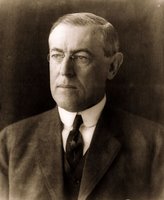 As the Bush administration worked to build public and multilateral support for an invasion of Iraq, a key piece of its case was the allegation that Saddam’s government had tried to purchase tons of uranium from Niger.
As the Bush administration worked to build public and multilateral support for an invasion of Iraq, a key piece of its case was the allegation that Saddam’s government had tried to purchase tons of uranium from Niger.Of course, the documents on which this allegation was based were later determined to be forgeries. President Bush leveled this allegation in his 2003 State of the Union, even though CIA officials informed Dick Cheney months before that they didn’t find the documents to be credible.
This wasn't the first time a White House either knowingly or unknowingly embraced forged documents to justify military action overseas. I learned this recently while reading Ted Morgan’s book “Reds.” During Woodrow Wilson's presidency, here's what happened.
In the fall of 1917, as World War I raged on, Edgar Sisson was sent to Russia by George Creel. Creel headed the Committee on Public Information, the U.S. government’s in-house propaganda machine. While in Russia, Sisson was contacted by an anti-Bolshevik journalist who gave him a stack of letters, written in Russian and addressed to Lenin and Trotsky. These letters, claimed the journalist, were sent by the German General Staff and proved that the Bolshevik leaders were actually secret agents working on behalf of the Germans.
According to author Ted Morgan:
On September 15, 1918, to prepare public opinion for the dispatch of American troops to Russia, President Wilson authorized the publication of the Sisson documents. … The documents were given to the press in installments and made the headlines that Sisson had been hoping for, such as “Lenin Exposed as German Spy.”Incidentally, Creel relied on two scholars for verification — and only one of them spoke Russian.
… The mainstream press accepted the documents as genuine. George Creel and his Committee on Public Information had gone to great lengths to check the ink, the paper, and the typefaces of the Sisson documents and pronounced them incontrovertibly genuine.
… a (Sept. 1918) dispatch to the State Department from the U.S. ambassador in London, Walter Hines Page, related that the British War Office had received the same documents …. “The (British) inference,” Page concluded, “is that all or most of [Sisson’s] alleged output are forgeries.”
… Creel continued to vouch for the documents’ authenticity. … After [President Wilson] had seen them in May, he hardened his stance toward the Bolsheviks and became more receptive to intervention in Russia.
… It was not until 1955 that the [Sisson documents] turned up in the National Archives and that, in a June 1956 article … George Kennan was able to demonstrate that they were forgeries.
It was inconceivable, Kennan pointed out, that German officers would give away the names of their agents as they did in the documents — it was contrary to tradecraft. More damningly still, in the letters supposedly from German officers, written in excellent Russian, they inexplicably signed their names in Cyrillic characters.
… Finally, the signatures of well-known figures such as Trotsky bore no resemblance to their usual signatures.
0 comments in History Has a Way of Repeating Itself
Post a Comment